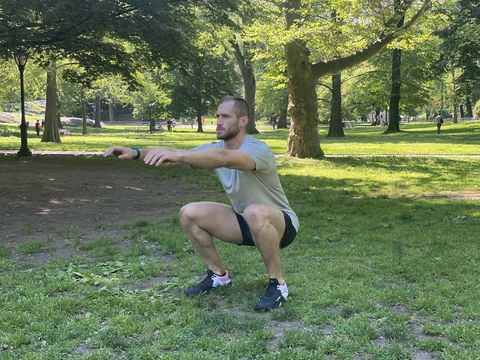Squats are one of the most formative movements at the base of just about every lower body workout.
Whether you load up with barbells, dumbbells, or just choose to rock with your own bodyweight, the squat is an effective way to get your quads, hamstrings, and glutes engaged all at once. Bodyweight squats, or air squats, can be an extremely useful tool in your fitness arsenal. You can use them to warm up and prime yourself for those loaded movements, or pump out a ton of reps together as the centerpiece of your no-gear, lower body workouts when you’re outside of a traditional gym environment.
The air squat might look simple at the outset since there’s no load involved—but there’s more to nailing the exercise than just bending your knees and dropping your butt to the floor.
“As an exercise, we want to make sure that our form is clean so that we’re not damaging our joints,” says Men’s Health fitness director Ebenezer Samuel, C.S.C.S. “But we’re really attacking the muscles that we want to train.”

Here, Samuel and MH fitness editor Brett Williams, NASM walk though the notes you should keep in mind anytime you bring the air squat into your workout. And establishing that proper squat form without a load won’t just help your bodyweight workouts. You’ll move better once you take these cues to the back squat, front squat, goblet squat, and more.
Keys to a Better Air Squat

Get Your Feet Right
While everyone has a slightly different ideal squat position due to anatomical variations, a good way to start your movement is with your feet just beyond shoulder width, with your toes turned slightly out. This should allow you to get to a good depth without too much chance of your knees caving in, a bad habit you’ll want to avoid,
Engage Your Core
Squeeze your abs, then roll your shoulders back and keep them engaged to stand up straight. That tension is a key to keeping your squat a squat. “The thing that separates a squat from any sort of hinge motion is going to be that his chest stays somewhat upright,” says Samuel. “Keeping his core tight, keeping his shoulder blades tight, is going to help him achieve that.”
Butt First to Bend
Don’t just bend at the knees to begin your descent into the lowering portion of the squat. Instead, push your butt back to initiate the movement. “Start with that motion because it’s critical, and the only way you’re going to squat right.” Once your rear is in gear, you can begin bending at the knees.
Air Squat Mistakes to Avoid
Don’t Knock Your Knees
Continue squeezing your glutes to keep yourself in a solid knee-safe position. This helps to turn your knees out and open, which is where you want to be—especially once you begin squatting with a load during other variations of the exercise. Want to work on this to help to reinforce this cue? Add some rounds of bodyweight glute bridges to your routine.
Stay on Your Feet
Another key mistake to avoid for air squats is elevated heels, so that all of your balance pitches forward into your toes. This is caused by a lack of Achilles flexibility. To help solve this problem, you can perform a mobilization drill to help you to keep your feet down.
Want to master even more moves? Check outour entire Form Check series.
Source: Read Full Article
